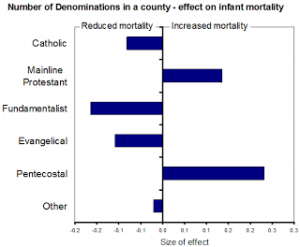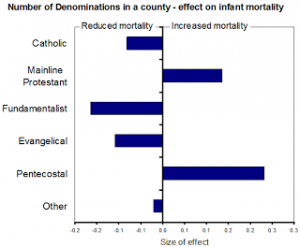 The US has a persistently high infant mortality rate when compared with other wealthy nations. The reasons for this a partly understood – poverty is a major risk factor for childhood death, And it’s believed that the high levels of income and racial stratification could be to blame. Problems with health are infrastructure are also thought to contribute.
The US has a persistently high infant mortality rate when compared with other wealthy nations. The reasons for this a partly understood – poverty is a major risk factor for childhood death, And it’s believed that the high levels of income and racial stratification could be to blame. Problems with health are infrastructure are also thought to contribute.
But could culture be partly to blame? Quite possibly, and one way to find out is to see whether the dominant culture in a region is linked to higher infant mortality. In the USA, religious denomination is an important facet of culture (even better, it’s easier to quantify than most other cultural traits).
So John Bartowski, of the University of San Antonio, and colleagues, looked at the number of churches of different denominations in 1,900 counties of the USA and compared this with the number of infant deaths as recorded by the Kids Count programme.
So this was a study of whether the numbers of different kinds of Christians in a given area affected infant mortality, rather than a study of whether individual families with particular beliefs have higher or lower mortality.
It’s an ecological study, in other words, looking at the dominant culture of a region. Similar to other recent studies on vaccination rates and trust. Of course, different denominations are present in poor areas compared with wealthy ones so Bartowski statistically controlled for region, black ethnicity, and poverty.
Batowski found that, in general, the more Catholic churches there were in an are the lower infant mortality was. Conversely, more Protestant churches meant higher infant mortality.
But this broad brush conceals a lot of detail. And the beauty of such a rich dataset was that Bartowksi could drill down to look at Protestant denominations in detail.
When he did that, he found that fundamentalist and evangelical churches actually were linked to lower infant mortality. It was mainline Protestant and in particular Pentecostal churches that were linked to higher mortality.
Bartowski speculates that the protective effect of Catholicism “is best explained by the emphasis that Catholicism places on creating a vibrant civic infrastructure, particularly one focused on promoting population health and well-being”, while the “pronatalist tendencies of fundamentalism and evangelicalism (advocacy for children and the unborn) contribute to significantly lower infant mortality rates”.
And Pentecostals? Well, he suspects that “Pentecostal suspicion of conventional medicine and its reliance instead on faith healing” accounts for the higher infant mortality.
But he does also acknowledge that this study can only be taken as preliminary. What, for example to make of the finding that mainline Protestants are linked to higher infant mortality? Is this a spurious result, perhaps as a result of some other unknown factor? Or is there something deeper going on?
![]()
Bartkowski, J., Xu, X., & Garcia, G. (2011). Religion and Infant Mortality in the U.S.: A Preliminary Study of Denominational Variations Religions, 2 (3), 264-276 DOI: 10.3390/rel2030264
 This article by Tom Rees was first published on Epiphenom. It is licensed under Creative Commons.
This article by Tom Rees was first published on Epiphenom. It is licensed under Creative Commons.













